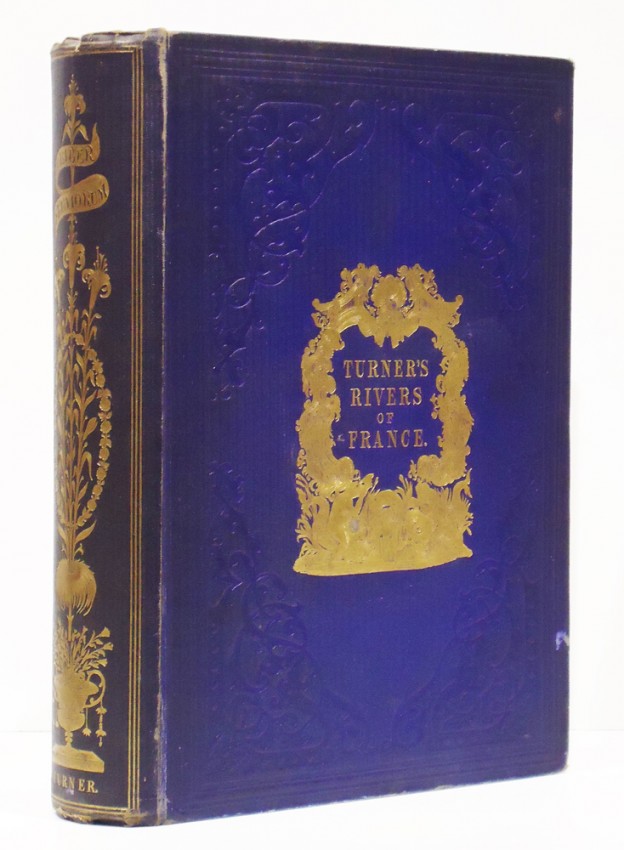TURNER, Joseph Mallord William (1775-1851, artist). Liber studiorum . London: J.M.W. Turner, 1812 [plates dated 1808-1819]. 2° (412 x 274mm). 65 (of 71 published) etched mezzotint and aquatint plates by J.M.W. Turner, J.C. Easling, Charles Turner William Say Robert Dunkarton Thomas Hodgetts, William Annis, George Clint F.C. Lewis, Henry Dawe, Thomas Lupton, and S.W. Reynolds after Turner, printed in coloured and black inks. (Variable light spotting and browning, one plate with small inkmark on margin.) Contemporary green morocco gilt by J. MacKenzie, covers with deep borders of thistle and leaf tools, foliate corner- and centre-pieces, gilt board edges, roll-tooled gilt turn-ins, spine gilt in compartments, lettered in one, the others decorated with thistle and leaf tools, gilt edges (spine lightly faded, light dampspotting on covers). 'A TRULY MONUMENTAL WORK, TAKING RANK WITH THE HIGHEST PRODUCTIONS OF TURNER'S GENIUS' (Rawlinson, p.iii). Turner conceived the Liber studiorum in part as a response to Claude Lorrain's volume of drawings entitled Liber veritatis , of which prints were published by John Boydell in three volumes under the same title (London: 1777-1804, see lot 82). The principal purpose of the Liber veritatis was to provide the artist with a private record of his finished oils and their owners, which also served the purpose of providing a reference by which genuine works could be distinguished from forgeries. Whereas Turner's Liber studiorum was always intended for publication, it shared some similarity of purpose. As the work progressed it acquired a momentum that was independent of the inspiration, and became 'a truly monumental work, taking rank with the highest productions of Turner's genius, and exhibiting intimately his strength, as indeed also his weakness, during a period of his life in which a large part of his strongest and soberest ... work was done' (Rawlinson, p.iii). The 71 plates were issued in 14 parts (each containing five etchings) over some four years; in addition to these, a further 20 were printed, but not published. The 65 plates contained in the present copy of the Liber studiorum are numbers: 1-9; 11-15; 17-27; 29-44; 46-54; 56-60; 62-71, of which 2 are in Rawlinson's first published state, 36 in the second, 22 in the third, and 5 in fourth or later states. Lowndes pp.2722-2723; W.G. Rawlinson Turner's Liber studiorum (London: 1878).
TURNER, Joseph Mallord William (1775-1851, artist). Liber studiorum . London: J.M.W. Turner, 1812 [plates dated 1808-1819]. 2° (412 x 274mm). 65 (of 71 published) etched mezzotint and aquatint plates by J.M.W. Turner, J.C. Easling, Charles Turner William Say Robert Dunkarton Thomas Hodgetts, William Annis, George Clint F.C. Lewis, Henry Dawe, Thomas Lupton, and S.W. Reynolds after Turner, printed in coloured and black inks. (Variable light spotting and browning, one plate with small inkmark on margin.) Contemporary green morocco gilt by J. MacKenzie, covers with deep borders of thistle and leaf tools, foliate corner- and centre-pieces, gilt board edges, roll-tooled gilt turn-ins, spine gilt in compartments, lettered in one, the others decorated with thistle and leaf tools, gilt edges (spine lightly faded, light dampspotting on covers). 'A TRULY MONUMENTAL WORK, TAKING RANK WITH THE HIGHEST PRODUCTIONS OF TURNER'S GENIUS' (Rawlinson, p.iii). Turner conceived the Liber studiorum in part as a response to Claude Lorrain's volume of drawings entitled Liber veritatis , of which prints were published by John Boydell in three volumes under the same title (London: 1777-1804, see lot 82). The principal purpose of the Liber veritatis was to provide the artist with a private record of his finished oils and their owners, which also served the purpose of providing a reference by which genuine works could be distinguished from forgeries. Whereas Turner's Liber studiorum was always intended for publication, it shared some similarity of purpose. As the work progressed it acquired a momentum that was independent of the inspiration, and became 'a truly monumental work, taking rank with the highest productions of Turner's genius, and exhibiting intimately his strength, as indeed also his weakness, during a period of his life in which a large part of his strongest and soberest ... work was done' (Rawlinson, p.iii). The 71 plates were issued in 14 parts (each containing five etchings) over some four years; in addition to these, a further 20 were printed, but not published. The 65 plates contained in the present copy of the Liber studiorum are numbers: 1-9; 11-15; 17-27; 29-44; 46-54; 56-60; 62-71, of which 2 are in Rawlinson's first published state, 36 in the second, 22 in the third, and 5 in fourth or later states. Lowndes pp.2722-2723; W.G. Rawlinson Turner's Liber studiorum (London: 1878).














Testen Sie LotSearch und seine Premium-Features 7 Tage - ohne Kosten!
Lassen Sie sich automatisch über neue Objekte in kommenden Auktionen benachrichtigen.
Suchauftrag anlegen